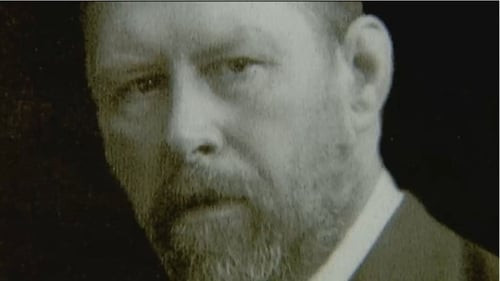Lost Bram Stoker Story Found in Dublin Library - "Gibbet Hill" Discovered After 130 Years
A long-lost short story by Bram Stoker, the author of the classic gothic novel "Dracula," has been unearthed by an amateur historian in Dublin who stumbled upon the work while browsing the archives at the National Library of Ireland.
Titled "Gibbet Hill", the story was uncovered by Brian Cleary, who found a reference to it in a Christmas supplement of the Dublin Daily Express newspaper from 1890. He made the discovery last year, after taking time off work following a sudden onset of deafness in 2021.
The short story was published just seven years before Dracula and has remained undocumented for more than 130 years. “Gibbet Hill” had never even been referenced in any Stoker bibliography.
Cleary contacted Stoker’s biographer Paul Murray, who confirmed that Gibbet Hill had indeed disappeared for more than a century.
"Gibbet Hill is very significant in terms of Stoker's development as a writer. 1890 was when he was a young writer and made his first notes for Dracula," Murray told AFP. "It's a classic Stoker story, the struggle between good and evil, evil which crops up in exotic and unexplained ways."
Perfect reading in the run up to Halloween... And the Dublin City Council Bram Stoker Festival knows it. “Gibbet Hill” is being published by the Rotunda Foundation - the fundraising arm of Dublin's Rotunda Hospital for which Cleary worked - and the first public reading of the story will take place at this year's festival, on Saturday 26 October.
Proceeds from the book will go towards the newly-established Charlotte Stoker Fund at the Rotunda Foundation, to fund research on preventable deafness in vulnerable newborns.
The Discovery of "Gibbet Hill"
Brian Cleary, a longtime fan of Stoker, was browsing the library’s archives last year when he noticed an 1891 advertisement in the Dublin Daily Express. The ad referenced a previously published story by Stoker, leading Cleary to an issue that had been printed a few weeks earlier, on December 17, 1890, which contained “Gibbet Hill” in full.
“I was just gobsmacked,” Cleary tells the New York Times’ Sarah Lyall. “I went and checked all the bibliographies, and it was nowhere. I wanted to turn around and shout, ‘Guess what I found?’ but there were proper researchers and academics there, and I was just an amateur.”
Cleary began researching the story and its author, consulting Paul Murray, author of From the Shadow of Dracula: A Life of Bram Stoker. Literary scholars have never referenced “Gibbet Hill,” and the story doesn’t appear in other Stoker archives, leading Murray to conclude that it had “disappeared for more than a century,” writes Artnet’s Richard Whiddington.
Significance of the Discovery
“Gibbet Hill” is an unsettling tale full of dark themes that Stoker would return to in Dracula. Set in Surrey, England, it follows an unnamed narrator who has an ominous encounter with three strange children near a murdered sailor’s grave.
“It’s a classic Stoker story,” Murray tells Peter Murphy of Agence France-Presse (AFP). “The struggle between good and evil—evil which crops up in exotic and unexplained ways.”
Murray adds that “Gibbet Hill” exemplifies Stoker’s development as a writer. It was printed the same year that Stoker began working on Dracula, a Gothic novel about an eponymous count who lives in Transylvania as a vampire. Derived from legends, the literary work informed an entire genre of vampire fiction and lore.
Publication and Charity
Stoker’s newly uncovered story is being republished in a book that features cover art and illustrations by Irish artist Paul McKinley. The proceeds will go to the Charlotte Stoker Fund, which supports research on deafness in newborn babies. The organization is named after the writer’s mother, who advocated for the deaf.
“I was like a baby learning to hear again,” he tells the Times. “A lot of things wouldn’t have happened if I hadn’t suffered from hearing loss.”
Public Reading and Exhibition
Later this month, the story will be read publicly for the first time at the Dublin City Council Bram Stoker Festival. The reading will take place at the Casino Marino, an 18th-century temple located not far from the author’s birthplace.
McKinley’s illustrations are inspired by the spooky imagery in Stoker’s story. For example, a “juicy, wet, oily painting” depicts one young character holding a pile of earthworms, as the artist tells AFP.
“When Brian sent me ‘Gibbet Hill,’ there was so much I could work with,” he adds. It was a “fascinating challenge” to make “new images for an old story that has been buried for so long.”
A Legacy Preserved
The discovery of “Gibbet Hill” is a testament to the power of serendipity and the dedication of amateur historians. It is also a reminder that even the most celebrated authors can have hidden gems in their archives. Thanks to Brian Cleary’s keen eye and the National Library of Ireland’s extensive collection, Stoker’s story will now be shared with a new generation of readers.
The story will be read publicly for the first time at the Dublin City Council Bram Stoker Festival. The reading will take place at the Casino Marino, an 18th-century temple located not far from the author’s birthplace.
The discovery of "Gibbet Hill" is a testament to the power of serendipity and the dedication of amateur historians. It is also a reminder that even the most celebrated authors can have hidden gems in their archives. Thanks to Brian Cleary’s keen eye and the National Library of Ireland’s extensive collection, Stoker’s story will now be shared with a new generation of readers.


















